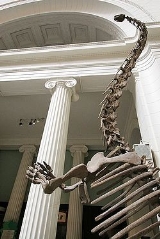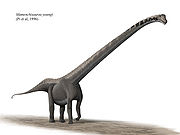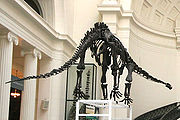
Mamenchisaurus
Encyclopedia
Mamenchisaurus was a plant-eating
four-legged
dinosaur
, known for its remarkably long neck
which made up half its total length. It is known from numerous species which ranged in time from 160 to 145 million years ago, from the Oxfordian to Tithonian
ages
of the late Jurassic
Period of China
.


 Mamenchisaurus was first discovered in 1952 on the construction site of the Yitang Highway in Sichuan
Mamenchisaurus was first discovered in 1952 on the construction site of the Yitang Highway in Sichuan
, China
. The partial skeleton fossil was then studied, and named Mamenchisaurus constructus in 1954, by the renowned Chinese paleontologist Professor C. C. Young
. The type specimen
had an incomplete neck with 14 vertebra preserved and none of these were complete . M.constructus was estimated at 13 m (42.7 ft) long.
In 1972, a second species of Mamenchisaurus was discovered (M. hochuanensis) with a neck that reached up to 9.3 m (30.5 ft) in length. This species had a complete neck preserved which contained 19 vertebrae. In 1994, the Sauroposeidon
was discovered in the United States
, with a neck estimated to be between 10.5 and 11.5 meters (34.5–37.5 feet) long, though its neck did not exceed that of the previously known Supersaurus
, with a neck reaching 13–14 meters (42.5–46 feet).
In 1993, M. sinocanadorum was described; this species possessed the longest cervical rib of any described sauropod dinosaur, measuring 4.1 m (13.5 ft). This is longer than the longest Sauroposeidon
cervical rib, which measures 3.42 m (11.2 ft).
In 2001, another M.hochuanensis specimen was described. It had skull, pectoral girdle and forelimb material preserved, all of which were missing from the holotype
. It was also found with four fused tail vertebra, which have expanded neural arches
and taller neural spines, that belong at the tip of the tail. It’s thought that these could be a weapon, such as a tail club
, or a sensory organ. Other Chinese sauropods, Shunosaurus
and Omeisaurus
, are also known to have had ’tail clubs’ but they differ in shape to that of M.hochuanensis.
Pinyin
mǎ (马 'horse') and mén (门 'gate'), while chi is a transliteration of xī (溪 'stream' or 'brook'), combined with the suffix -saurus (from Greek
sauros meaning 'lizard').
It was intended to name the reptile after the place where its fossil was first found — a construction site next to the Mǎmíngxī (马鸣溪) Ferry Crossing by the Jinsha River
(金沙江, the westernmost major headwater stream of the Yangtze River
), near Yibin
(宜宾) in Sichuan Province of China
. However, due to an accentual mix-up by Young
, the location name Mǎmíngxī (马鸣溪 'horse-neighing brook') was mistaken as Mǎménxī (马门溪 'horse-gate brook').
The fact that the first Mamenchisaurus fossil was found as the result of construction work led to Young's naming the type species
as Mamenchisaurus constructus.
Herbivore
Herbivores are organisms that are anatomically and physiologically adapted to eat plant-based foods. Herbivory is a form of consumption in which an organism principally eats autotrophs such as plants, algae and photosynthesizing bacteria. More generally, organisms that feed on autotrophs in...
four-legged
Quadruped
Quadrupedalism is a form of land animal locomotion using four limbs or legs. An animal or machine that usually moves in a quadrupedal manner is known as a quadruped, meaning "four feet"...
dinosaur
Dinosaur
Dinosaurs are a diverse group of animals of the clade and superorder Dinosauria. They were the dominant terrestrial vertebrates for over 160 million years, from the late Triassic period until the end of the Cretaceous , when the Cretaceous–Paleogene extinction event led to the extinction of...
, known for its remarkably long neck
Neck
The neck is the part of the body, on many terrestrial or secondarily aquatic vertebrates, that distinguishes the head from the torso or trunk. The adjective signifying "of the neck" is cervical .-Boner anatomy: The cervical spine:The cervical portion of the human spine comprises seven boney...
which made up half its total length. It is known from numerous species which ranged in time from 160 to 145 million years ago, from the Oxfordian to Tithonian
Tithonian
In the geologic timescale the Tithonian is the latest age of the Late Jurassic epoch or the uppermost stage of the Upper Jurassic series. It spans the time between 150.8 ± 4 Ma and 145.5 ± 4 Ma...
ages
Faunal stage
In chronostratigraphy, a stage is a succession of rock strata laid down in a single age on the geologic timescale, which usually represents millions of years of deposition. A given stage of rock and the corresponding age of time will by convention have the same name, and the same boundaries.Rock...
of the late Jurassic
Jurassic
The Jurassic is a geologic period and system that extends from about Mya to Mya, that is, from the end of the Triassic to the beginning of the Cretaceous. The Jurassic constitutes the middle period of the Mesozoic era, also known as the age of reptiles. The start of the period is marked by...
Period of China
China
Chinese civilization may refer to:* China for more general discussion of the country.* Chinese culture* Greater China, the transnational community of ethnic Chinese.* History of China* Sinosphere, the area historically affected by Chinese culture...
.
Discoveries



Sichuan
' , known formerly in the West by its postal map spellings of Szechwan or Szechuan is a province in Southwest China with its capital in Chengdu...
, China
China
Chinese civilization may refer to:* China for more general discussion of the country.* Chinese culture* Greater China, the transnational community of ethnic Chinese.* History of China* Sinosphere, the area historically affected by Chinese culture...
. The partial skeleton fossil was then studied, and named Mamenchisaurus constructus in 1954, by the renowned Chinese paleontologist Professor C. C. Young
Yang Zhongjian
Yang Zhongjian , courtesy name Keqiang , also known as C.C. Young, was one of China's foremost paleontologists. He has been called the 'Father of Chinese vertebrate paleontology'...
. The type specimen
Type species
In biological nomenclature, a type species is both a concept and a practical system which is used in the classification and nomenclature of animals and plants. The value of a "type species" lies in the fact that it makes clear what is meant by a particular genus name. A type species is the species...
had an incomplete neck with 14 vertebra preserved and none of these were complete . M.constructus was estimated at 13 m (42.7 ft) long.
In 1972, a second species of Mamenchisaurus was discovered (M. hochuanensis) with a neck that reached up to 9.3 m (30.5 ft) in length. This species had a complete neck preserved which contained 19 vertebrae. In 1994, the Sauroposeidon
Sauroposeidon
Sauroposeidon is a genus of sauropod dinosaur known from four neck vertebrae that were found in the southeastern portion of the US state of Oklahoma. The fossils were found in rocks dating to the Early Cretaceous, a period when the sauropods of North America had diminished in both size and...
was discovered in the United States
United States
The United States of America is a federal constitutional republic comprising fifty states and a federal district...
, with a neck estimated to be between 10.5 and 11.5 meters (34.5–37.5 feet) long, though its neck did not exceed that of the previously known Supersaurus
Supersaurus
Supersaurus is a genus of diplodocid sauropod dinosaur discovered by Vivian Jones of Delta, Colorado, in the Upper Jurassic Morrison Formation of Colorado in 1972. The fossil remains came from the Brushy Basin Member of the formation, dating to about 153 million years ago...
, with a neck reaching 13–14 meters (42.5–46 feet).
In 1993, M. sinocanadorum was described; this species possessed the longest cervical rib of any described sauropod dinosaur, measuring 4.1 m (13.5 ft). This is longer than the longest Sauroposeidon
Sauroposeidon
Sauroposeidon is a genus of sauropod dinosaur known from four neck vertebrae that were found in the southeastern portion of the US state of Oklahoma. The fossils were found in rocks dating to the Early Cretaceous, a period when the sauropods of North America had diminished in both size and...
cervical rib, which measures 3.42 m (11.2 ft).
In 2001, another M.hochuanensis specimen was described. It had skull, pectoral girdle and forelimb material preserved, all of which were missing from the holotype
Holotype
A holotype is a single physical example of an organism, known to have been used when the species was formally described. It is either the single such physical example or one of several such, but explicitly designated as the holotype...
. It was also found with four fused tail vertebra, which have expanded neural arches
Vertebral arch
The vertebral arch is the posterior part of a vertebra.It consists of a pair of pedicles and a pair of laminae, and supports seven processes:* four articular processes* two transverse processes* one spinous process...
and taller neural spines, that belong at the tip of the tail. It’s thought that these could be a weapon, such as a tail club
Club (zoology)
In zoology, a club is a bony mass at the end of the tail of some dinosaurs and of some mammals, most notably the ankylosaurids and the glyptodonts...
, or a sensory organ. Other Chinese sauropods, Shunosaurus
Shunosaurus
Shunosaurus, meaning "Shu Lizard", is a genus of sauropod dinosaur from Middle Jurassic beds in Sichuan Province in China, 170 million years ago...
and Omeisaurus
Omeisaurus
Omeisaurus is a genus of sauropod dinosaur from the Middle Jurassic Period of what is now China. Its name comes from Mount Emei, where it was discovered in the lower Shaximiao Formation of Sichuan Province.Like other sauropods, Omeisaurus was herbivorous and large...
, are also known to have had ’tail clubs’ but they differ in shape to that of M.hochuanensis.
Naming
Mamenchisaurus means 'Mamenchi lizard', from the ChineseChinese language
The Chinese language is a language or language family consisting of varieties which are mutually intelligible to varying degrees. Originally the indigenous languages spoken by the Han Chinese in China, it forms one of the branches of Sino-Tibetan family of languages...
Pinyin
Pinyin
Pinyin is the official system to transcribe Chinese characters into the Roman alphabet in China, Malaysia, Singapore and Taiwan. It is also often used to teach Mandarin Chinese and spell Chinese names in foreign publications and used as an input method to enter Chinese characters into...
mǎ (马 'horse') and mén (门 'gate'), while chi is a transliteration of xī (溪 'stream' or 'brook'), combined with the suffix -saurus (from Greek
Ancient Greek
Ancient Greek is the stage of the Greek language in the periods spanning the times c. 9th–6th centuries BC, , c. 5th–4th centuries BC , and the c. 3rd century BC – 6th century AD of ancient Greece and the ancient world; being predated in the 2nd millennium BC by Mycenaean Greek...
sauros meaning 'lizard').
It was intended to name the reptile after the place where its fossil was first found — a construction site next to the Mǎmíngxī (马鸣溪) Ferry Crossing by the Jinsha River
Jinsha River
Jinsha River is the westernmost of the major headwater streams of the Yangtze River, southwestern China.Its headwaters rise in the Wulan and Kekexili ranges in western Qinghai province, to the south of the Kunlun Mountains, and on the northern slope of the Tanggula Mountains on the border of the...
(金沙江, the westernmost major headwater stream of the Yangtze River
Yangtze River
The Yangtze, Yangzi or Cháng Jiāng is the longest river in Asia, and the third-longest in the world. It flows for from the glaciers on the Tibetan Plateau in Qinghai eastward across southwest, central and eastern China before emptying into the East China Sea at Shanghai. It is also one of the...
), near Yibin
Yibin
-Administrative divisions:-Economy:The city's industry focuses on electronics, food products, and power generation. It also produces paper, silk, and leather products...
(宜宾) in Sichuan Province of China
China
Chinese civilization may refer to:* China for more general discussion of the country.* Chinese culture* Greater China, the transnational community of ethnic Chinese.* History of China* Sinosphere, the area historically affected by Chinese culture...
. However, due to an accentual mix-up by Young
Yang Zhongjian
Yang Zhongjian , courtesy name Keqiang , also known as C.C. Young, was one of China's foremost paleontologists. He has been called the 'Father of Chinese vertebrate paleontology'...
, the location name Mǎmíngxī (马鸣溪 'horse-neighing brook') was mistaken as Mǎménxī (马门溪 'horse-gate brook').
The fact that the first Mamenchisaurus fossil was found as the result of construction work led to Young's naming the type species
Type species
In biological nomenclature, a type species is both a concept and a practical system which is used in the classification and nomenclature of animals and plants. The value of a "type species" lies in the fact that it makes clear what is meant by a particular genus name. A type species is the species...
as Mamenchisaurus constructus.
Species
- M. anyuensis He, Yang, Cai, Li & Liu, 1996. Approximately 21 metres (68.9 ft) in length. Known from both the Suining FormationSuining FormationThe Suining Formation is a geological formation in China whose strata date back to the Late Jurassic. Dinosaur remains are among the fossils that have been recovered from the formation.-Dinosaurs:-References:...
and Penglaizhen FormationPenglaizhen FormationThe Penglaizhen Formation is a geological formation in Sichuan, China, whose strata date back to the Late Jurassic. Dinosaur remains are among the fossils that have been recovered from the formation.-Vertebrate paleofauna:...
. - M. constructus Young, 1954: (Type speciesType speciesIn biological nomenclature, a type species is both a concept and a practical system which is used in the classification and nomenclature of animals and plants. The value of a "type species" lies in the fact that it makes clear what is meant by a particular genus name. A type species is the species...
) The holotypeHolotypeA holotype is a single physical example of an organism, known to have been used when the species was formally described. It is either the single such physical example or one of several such, but explicitly designated as the holotype...
specimen, represented by a partial skeleton and was 13 ft (4 m) long. - ?M. fuxiensis Hou, Zhao & Chu, 1976: Partial skeleton, include parts of a skull. It was originally named ZigongosaurusZigongosaurusZigongosaurus is a genus of sauropod dinosaur from the Middle Jurassic-Late Jurassic-age Shaximiao Formation of Zigong, Sichuan, China...
, and may be a different genus. - M. hochuanensis Young & Zhao, 1972: Four partial skeletons. Known from Shaximiao Formation and 22 m (72 ft) in length.
- M. jingyanensis Zhang, Li & Zeng, 1998. Known from Shaximiao Formation and estimated between 20 to 26 m (65.6 to 85.3 ft) in length.
- M. sinocanadorum D. Russell & Zheng, 1994: Partial skull, isolated bones. Known from the upper part of the Shishugou FormationShishugou FormationThe Shishugou Formation is a geological formation in Xinjiang, China, whose strata date back to the Late Jurassic period. Dinosaur remains are among the fossils that have been recovered from the formation....
(about 160 Ma ago), it may have been the largest, estimated up to 26 meters (85 ft) in length. - M. youngi Pi, Ouyang & Ye, 1996: Mamenchisaurus youngi (pronunciation YOUNG-eye) was unearthed in Xinmin County, ZigongZigongZigong , ancient name Ziliujing and Gongjing, is a prefecture-level city and the third largest city in Sichuan Province, in southwest China.-Geography:...
City in SichuanSichuan' , known formerly in the West by its postal map spellings of Szechwan or Szechuan is a province in Southwest China with its capital in Chengdu...
Province, China, in 1989. The species was named in honour of YoungYang ZhongjianYang Zhongjian , courtesy name Keqiang , also known as C.C. Young, was one of China's foremost paleontologists. He has been called the 'Father of Chinese vertebrate paleontology'...
. It was a very complete and articulated specimen presvering all the vertebra from the head up until the 8th tail vertebra. It had 18 neck vertebra. At 16 meters (52 ft) long with a 6.5-meter (21 ft) neck, is relatively small among various species of Mamenchisaurus.
External links
- Dinosaur.net.cn (in Chinese and English)
- Mamenchisaurus at DinoData

